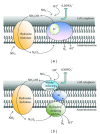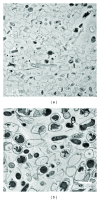Anaerobic ammonium oxidation: from laboratory to full-scale application
- PMID: 23956985
- PMCID: PMC3730388
- DOI: 10.1155/2013/469360
Anaerobic ammonium oxidation: from laboratory to full-scale application
Abstract
From discovery in the early 1990s to completion of full-scale anammox reactor, it took almost two decades to uncover the secret veil of anammox bacteria. There were three milestones during the commercialization of anammox: the development of the first enrichment culture medium, the completion of the first commercial anammox reactor, and the fast start-up of full-scale anammox plant. Till now, the culture of anammox bacteria experienced a big progress through two general strategies: (a) to start up a reactor from scratch and (b) to seed the reactor with enriched anammox sludge. The first full-scale anammox reactor took 3.5 years to realize full operation using the first approach due to several reasons besides the lack of anammox sludge. On the other hand, the first Asian anammox reactor started up in two months, thanks to the availability of anammox seed. Along with the implementation of anammox plants, anammox eventually becomes the priority choice for ammonium wastewater treatment.
Figures






Similar articles
-
Engineering application of anaerobic ammonium oxidation process in wastewater treatment.World J Microbiol Biotechnol. 2017 Aug;33(8):153. doi: 10.1007/s11274-017-2313-7. Epub 2017 Jul 3. World J Microbiol Biotechnol. 2017. PMID: 28674924 Review.
-
Start-up characteristics of a granule-based anammox UASB reactor seeded with anaerobic granular sludge.Biomed Res Int. 2013;2013:396487. doi: 10.1155/2013/396487. Epub 2013 Dec 23. Biomed Res Int. 2013. PMID: 24455691 Free PMC article.
-
Performance evaluation of the anammox hybrid reactor seeded with mixed inoculum sludge.Environ Technol. 2016;37(9):1065-76. doi: 10.1080/09593330.2015.1100686. Epub 2015 Nov 9. Environ Technol. 2016. PMID: 26411578
-
High-rate nitrogen removal from waste brine by marine anammox bacteria in a pilot-scale UASB reactor.Appl Microbiol Biotechnol. 2018 Feb;102(3):1501-1512. doi: 10.1007/s00253-017-8663-0. Epub 2017 Dec 4. Appl Microbiol Biotechnol. 2018. PMID: 29204898
-
Application of the Anammox in China-A Review.Int J Environ Res Public Health. 2020 Feb 9;17(3):1090. doi: 10.3390/ijerph17031090. Int J Environ Res Public Health. 2020. PMID: 32050414 Free PMC article. Review.
Cited by
-
Start-up of a full-scale two-stage partial nitritation/anammox (PN/A) process treating reject water from high solid anaerobic sludge digestion (HSAD).Water Res X. 2024 Sep 23;25:100259. doi: 10.1016/j.wroa.2024.100259. eCollection 2024 Dec 1. Water Res X. 2024. PMID: 39429521 Free PMC article.
-
Microbial community dynamics in an ANAMMOX reactor for piggery wastewater treatment with startup, raising nitrogen load, and stable performance.AMB Express. 2018 Oct 1;8(1):156. doi: 10.1186/s13568-018-0686-0. AMB Express. 2018. PMID: 30276499 Free PMC article.
-
Adjusted bacterial cooperation in anammox community to adapt to high ammonium in wastewater treatment plant.Water Res X. 2024 Sep 18;25:100258. doi: 10.1016/j.wroa.2024.100258. eCollection 2024 Dec 1. Water Res X. 2024. PMID: 39381622 Free PMC article.
-
Ecological Aerobic Ammonia and Methane Oxidation Involved Key Metal Compounds, Fe and Cu.Life (Basel). 2022 Nov 7;12(11):1806. doi: 10.3390/life12111806. Life (Basel). 2022. PMID: 36362966 Free PMC article. Review.
-
Evaluation of granular anaerobic ammonium oxidation process for the disposal of pre-treated swine manure.PeerJ. 2014 Apr 8;2:e336. doi: 10.7717/peerj.336. eCollection 2014. PeerJ. 2014. PMID: 24765570 Free PMC article.
References
-
- Shiskowski DM, Mavinic DS. Biological treatment of a high ammonia leachate: influence of external carbon during initial startup. Water Research. 1998;32(8):2533–2541.
-
- Ahn Y-H. Sustainable nitrogen elimination biotechnologies: a review. Process Biochemistry. 2006;41(8):1709–1721.
-
- Jetten MSM, Horn SJ, Van Loosdrecht MCM. Towards a more sustainable municipal wastewater treatment system. Water Science and Technology. 1997;35(9):171–180.
-
- Van Loosdrecht MCM, Jetten MSM. Microbiological conversions in nitrogen removal. Water Science and Technology. 1998;38(1):1–7.
-
- Pynaert K, Smets BF, Beheydt D, Verstraete W. Start-up of autotrophic nitrogen removal reactors via sequential biocatalyst addition. Environmental Science and Technology. 2004;38(4):1228–1235. - PubMed
Publication types
MeSH terms
Substances
LinkOut - more resources
Full Text Sources
Other Literature Sources

